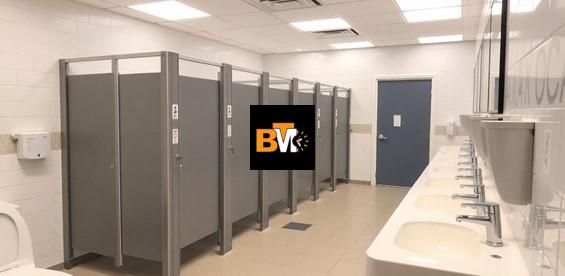Overview of OBC Regulations
The Ontario Building Code (OBC) sets the baseline for universal public washroom standards. It’s all about safety and structural integrity. Think of it as the foundation upon which accessibility is built.
These regulations cover everything from ventilation to plumbing. They ensure washrooms are safe and functional for everyone. Regular updates keep the code current with new technologies and best practices.
OBC compliance is mandatory for all new constructions and renovations. Ignoring these rules can lead to serious delays and fines.
Importance of Accessibility
Accessibility goes beyond just meeting the minimum requirements. It’s about creating spaces that are usable by everyone, regardless of ability. This includes things like wider doorways, grab bars, and accessible sinks.
Accessibility isn’t just a nice-to-have; it’s a legal requirement under the AODA. Businesses need to take it seriously. It’s also the right thing to do.
Creating accessible washrooms shows respect for all members of the community. It fosters inclusivity and ensures everyone can participate fully in public life.
Compliance with AODA
The Accessibility for Ontarians with Disabilities Act (AODA) aims to make Ontario fully accessible by 2025. This includes strict guidelines for public washrooms. AODA compliance is not optional.
- Accessible design features are a must.
- Regular audits help maintain compliance.
- Training staff on accessibility best practices is key.
Meeting AODA standards ensures equal access and avoids legal trouble. It’s an investment in a more inclusive future. The universal design approach benefits everyone.
Accessible Washroom Requirements In Ontario
AODA Compliance Guidelines
Making sure washrooms are accessible is a big deal in Ontario. The Accessibility for Ontarians with Disabilities Act (AODA) sets the rules. AODA compliance means removing barriers so everyone can use these facilities.
Think about things like wider doorways and grab bars. These small changes make a huge difference. It’s about more than just following the law; it’s about being inclusive.
Businesses need to know these guidelines. It’s not just a suggestion; it’s the law. Ignoring it can lead to problems.
Barrier-Free Design Standards
Barrier-free design is key. It’s all about creating spaces that everyone can use, regardless of their abilities. This means thinking about things like the height of sinks and the placement of soap dispensers.
Here are some important things to consider:
- Clear floor space for wheelchairs
- Easy-to-use faucets
- Proper signage
Designing with accessibility in mind from the start saves time and money. Retrofitting later can be a headache.
Facilities for Individuals with Disabilities
Specific facilities are needed for people with disabilities. This includes things like:
- Wheelchair-accessible stalls
- Grab bars
- Emergency call buttons
These features aren’t just extras; they’re essential. They allow people to use washrooms safely and comfortably. Accessible washrooms show respect and consideration for all users.
It’s important to regularly check and maintain these facilities. Make sure everything is working properly and is easy to use.
Health and Safety Regulations for Washrooms

Overview of OHSA Requirements
Ontario’s Occupational Health and Safety Act (OHSA) sets the stage. It’s all about keeping workers safe and healthy. This includes basic health and safety requirements for washrooms.
Think of it as the foundation. Specific regulations build upon this, tailored to different work environments.
OHSA is the backbone of workplace safety in Ontario.
Specific Regulations for Different Industries
Not all workplaces are created equal. Construction sites have different needs than office buildings. That’s why OHSA has industry-specific rules.
For example, the Construction Projects regulation details toilet requirements on construction sites. The Industrial Establishments regulation covers showers.
| Industry | Regulation | |
| Construction | Construction Projects Regulation | |
| Industrial | Industrial Establishments Regulation | |
| Mines and Mining | Mines and Mining Plant regulation |
Maintenance and Hygiene Standards
Cleanliness is key. Regular cleaning protocols are a must. This includes providing soap, toilet paper, and hand-drying facilities.
Sanitary conditions are non-negotiable. Washrooms must be free from pests and maintained in good repair. Reporting and addressing issues promptly is also important for health and safety.
Here are some key maintenance points:
- Regular cleaning schedules
- Adequate supplies (soap, paper towels)
- Prompt repairs of any damage
Construction Project Washroom Regulations
Requirements for Temporary Facilities
Construction sites need temporary washrooms right from the start. These aren’t optional. Think about it: workers need a place to go, and it needs to be safe and sanitary.
These facilities must be easy to get to from the work area. They also need to protect people from the weather and keep them out of sight.
They should have things like toilet paper and hand-washing stuff. If running water isn’t available, chemical toilets or privies are okay, but they still need to be up to par.
Sanitation Standards on Construction Sites
Keeping construction site washrooms clean is a big deal. It’s not just about appearances; it’s about health and safety. Regular cleaning is a must.
These facilities need to be serviced often. This means cleaning, sanitizing, and making sure everything is in good shape.
Someone needs to keep a record of all the cleaning and servicing. This helps show that the site is following the rules.
Compliance with Occupational Health Standards
Construction sites have to follow specific rules to keep workers safe. This includes having enough washrooms for everyone.
These regulations cover things like the type of toilets allowed. For example, they might require flush toilets if there’s running water available. If not, chemical toilets are fine.
Also, employers need to make sure the washrooms are well-stocked with supplies. This means toilet paper, soap, and ways to dry your hands. It’s all about keeping things sanitary and preventing the spread of germs.
Public Washroom Maintenance Standards

Regular Cleaning Protocols
Keeping public washrooms clean isn’t just about appearances; it’s about public health. Regular cleaning prevents the spread of germs and keeps everyone safer. Think about it: a clean washroom shows you care.
Cleaning schedules should be frequent and consistent. High-traffic washrooms need more attention. This includes disinfecting surfaces, restocking supplies, and emptying trash bins.
Proper training for cleaning staff is key. They need to know how to use cleaning products safely and effectively. This ensures a thorough job every time.
Sanitary Conditions Requirements
Sanitary conditions go beyond just being clean. It’s about creating a space that minimizes the risk of contamination. This means paying attention to details.
Proper ventilation is a must. It helps reduce moisture and odors, which can contribute to bacterial growth. Good ventilation makes a big difference.
Providing adequate supplies is also important. Soap, paper towels, and hand sanitizers should always be readily available. Running out of these essentials defeats the purpose.
Maintaining sanitary conditions is a shared responsibility. Users can help by practicing good hygiene habits, like washing their hands thoroughly.
Reporting and Addressing Issues
Even with the best maintenance, problems can arise. Having a system for reporting and addressing issues is crucial. This ensures that problems are dealt with quickly.
Establish a clear process for reporting issues. This could involve a simple form or a dedicated phone number. Make it easy for people to report problems.
Respond to reports promptly. Ignoring issues can lead to bigger problems down the road. Quick action shows you’re serious about maintenance.
Regular inspections can help identify potential problems before they become major issues. This proactive approach can save time and money in the long run.
Legal Implications of Non-Compliance
Potential Fines and Penalties
Ignoring public washroom laws in Ontario can lead to some serious financial hits. Non-compliance isn’t just a slap on the wrist; it can result in significant fines for businesses. The exact amount varies depending on the severity and frequency of the violation, but it’s enough to hurt the bottom line.
These fines aren’t just a one-time thing. Repeated offenses can lead to even steeper penalties, and nobody wants that. It’s way better to just follow the rules from the start.
Staying compliant avoids these financial burdens and keeps your business running smoothly.
Legal Responsibilities of Business Owners
Business owners have a legal duty to ensure their public washrooms meet all the required standards. This isn’t just about being nice; it’s the law. Owners are responsible for understanding and implementing all relevant regulations.
This includes accessibility requirements, hygiene standards, and all other aspects covered by the Ontario Building Code and AODA. Ignorance isn’t an excuse; owners are expected to be informed and proactive.
Failing to meet these responsibilities can open the door to legal action.
Case Studies of Non-Compliance
Let’s look at some real-world examples. There have been cases where businesses faced lawsuits due to inaccessible washrooms. These cases highlight the importance of AODA compliance.
Other businesses have been penalized for failing to maintain adequate hygiene standards. These situations serve as a reminder that regular maintenance is crucial.
These case studies show that non-compliance has real consequences. It’s not worth the risk to cut corners on washroom regulations.
Future Trends in Public Washroom Regulations
Emerging Technologies in Hygiene
We’re seeing some cool stuff pop up in public washrooms. Think touch-free fixtures becoming the norm. Smart systems that monitor and adjust things like soap levels and cleaning schedules are also on the rise.
These technologies aren’t just about convenience. They’re about cutting down on the spread of germs and making sure everything stays clean.
The focus is shifting towards proactive hygiene management, using data to predict and prevent issues before they arise.
Sustainability Practices
Going green is a big deal, even in washrooms. Water-saving toilets and faucets are becoming more common. Also, expect to see more eco-friendly materials used in construction and maintenance.
Businesses are looking for ways to reduce their environmental footprint. This includes everything from using recycled paper products to installing energy-efficient lighting.
Here are some sustainable practices:
- Water conservation technologies.
- Use of recycled materials.
- Waste reduction programs.
Evolving Accessibility Standards
Accessibility is always improving. Expect to see even more inclusive designs that cater to a wider range of needs. This means going beyond the basics to create spaces that are truly usable by everyone.
Think about adjustable sinks, better signage, and layouts that are easy to navigate. The goal is to make public washrooms welcoming and accessible for all.
Accessibility is not just a requirement; it’s a commitment to inclusivity.
Wrapping It Up
So, there you have it. Ontario’s public washroom rules are all about making sure everyone has access to clean and safe facilities. Whether you’re a business owner or just someone who uses these spaces, knowing the regulations can really help. It’s not just about having a toilet; it’s about making sure it’s usable for everyone, including those with disabilities. Keeping up with these laws might seem like a hassle, but it’s important for public health and comfort. If you’re ever unsure, don’t hesitate to check the guidelines or ask for help. After all, everyone deserves a decent place to take care of business.







Leave a Reply